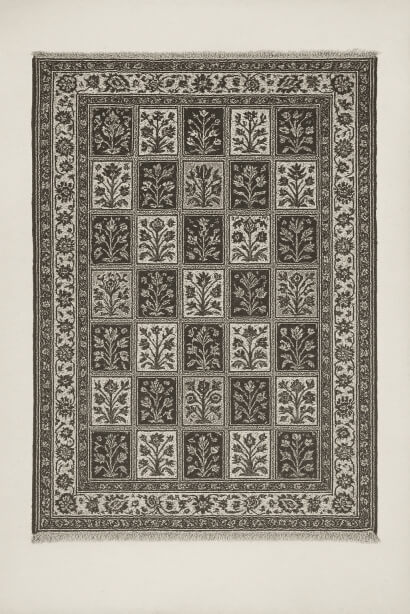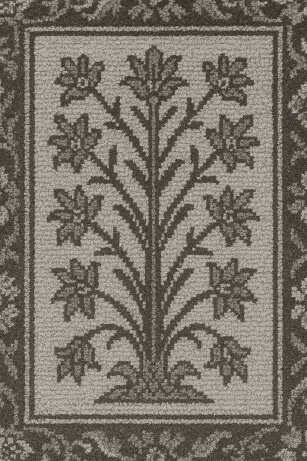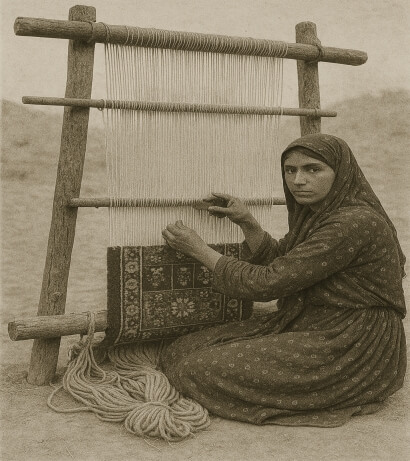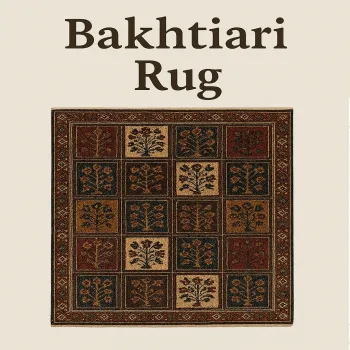Bakhtiari rugs are among the most distinctive examples of Persian rug-making and have a long history. Their history is deeply intertwined with that of the Bakhtiari tribe, who live in southwestern Persia. Traditionally leading a nomadic lifestyle, the tribe's carpet-making techniques were greatly influenced by this way of life. Originally made by the Bakhtiari tribe for their own use, these carpets gradually gained renown on the Persian rug market. Bakhtiari rugs hold special historical significance as the patterns and colours reflect the experiences and cultural influences gained during the tribe's migrations.
Bakhtiari carpet weaving flourished in the late 19th and early 20th centuries when masterpieces created by these nomadic artisans reached the international market. They were particularly prized for their durability and dense knotting, which made them ideal for nomadic living. Each rug is unique, often telling the story of the tribe through the use of symbolic elements.
What makes Persian Bakhtiari rugs so special?
Bakhtiari rugs are among the most exceptional examples of Persian carpet-making. They feature unique techniques and motifs that distinguish them from carpets produced in other regions. One of their most distinctive features is the square pattern, one of the most recognisable Bakhtiari rug motifs. This pattern is often filled with flowers, trees or geometric shapes that carry symbolic meanings related to nature and the cycle of life.

Another distinctive feature of Bakhtiari rugs is their dense and thick knotting, which makes them highly durable. This is particularly important given the nomadic lifestyle of the tribe, where carpets were often used outdoors and had to withstand harsh conditions. The carpets are typically woven from wool dyed with natural dyes sourced from the local environment, ensuring their authentic appearance and quality.
Bakhtiari rugs are therefore valued not only for their visual aesthetics, but also for their deep cultural roots, which are linked to the history and way of life of the Bakhtiari tribe.
The significance of the tree motif in Bakhtiari Persian carpets
The tree is one of the most recognisable and important motifs in Bakhtiari Persian rugs, and has deep symbolic meaning for the Bakhtiari tribe. Often appearing as a tree of life, it symbolises the cycle of life, rebirth and a close connection to nature. In Persian culture, the tree of life also has symbolic significance, representing vitality and longevity.

These trees serve not only an aesthetic purpose, but also tell stories about the tribe's natural environment, the changing seasons and fertility. Bakhtiari carpet makers depict the tree motif in various ways, often decorating it with stylised flowers, fruits and leaves. This motif expresses the tribe's deep respect for nature, an integral part of their lives and culture.
Therefore, the tree motif is not only decorative, but also a visual expression of the Bakhtiari tribe's beliefs and values. Through this element, the carpet makers convey messages about nature, life and survival that have been passed down through the generations.
The legacy and heritage of the Bakhtiari tribe
Located in southwestern Persia, the Bakhtiari tribe has been a symbol of nomadic life, traditions and crafts for centuries. Their heritage is reflected not only in carpet making, but also in their culture, customs and way of life. Carpet making was an integral part of their daily existence, providing sustenance for the community during migrations and helping to preserve their cultural identity.

The Bakhtiari were renowned for their carpet-making techniques, which were passed down through the generations. The characteristics of their nomadic lifestyle, such as frequent migration, also influenced the design and style of the rugs. Each rug is an imprint of the tribe's journey and history, reflecting nature, everyday events and beliefs.
Bakhtiari rugs are therefore beautiful handicrafts that embody the tribe's historical and cultural heritage. Each one is a tangible link to the tribe's past, preserving and conveying its traditions and values to this day.
Characteristic design elements of Bakhtiari Persian rugs:
The designs of these rugs are deeply rooted in the traditions of the Bakhtiari tribe and have a distinctive appearance. The most recognisable design element is the square grid pattern, known as 'khesti', which is often filled with flowers, trees or geometric motifs. This square grid structure symbolises the nomadic lifestyle of the Bakhtiari people, with the rugs representing various elements of nature and emphasising the fertility of the earth and the cycle of life.
These rugs often feature large, separate motifs whose symmetry and rich detail distinguish them from other Persian rugs. Bakhtiari rugs feature strong, vibrant colours derived from natural dyes, such as shades of red, blue and green. These colours further enhance the rugs' aesthetic appeal and timeless beauty.
In addition to their unique patterns, the thick, strong knotting of Bakhtiari rugs contributes to their durability, which was particularly important to the nomadic tribe. Therefore, the design elements are not only aesthetically unique, but also served a practical purpose, ensuring that these rugs have remained popular for generations.
The production process of Bakhtiari carpets
The production of Bakhtiari carpets is based on craft techniques that have been refined over centuries and are deeply rooted in the tribe's culture. The first step in the production process is preparing the raw material, the wool. The wool used for Bakhtiari rugs is typically sourced from local sheep that are sheared by hand. It is then cleaned, spun and dyed with natural dyes. These dyes are mostly derived from plants, roots and minerals, ensuring the colours are both durable and vibrant.

Once the wool has been dyed, the weaving process can begin. Traditionally, looms are set up in homes, and the production of a carpet can take weeks or even months depending on its size and complexity. Bakhtiari carpets are characterised by their thick, dense knotting, which makes them extremely durable. The hand-knotting technique requires great precision, and experienced weavers pass their knowledge on from generation to generation.
The end result is a beautiful, unique and extremely durable carpet. Every step of the manufacturing process, from wool preparation to weaving, ensures the outstanding quality of Bakhtiari rugs, which are recognised and appreciated all over the world.
Colours and materials in Bakhtiari rugs
The stunning beauty of Bakhtiari rugs is partly due to the materials and colours used. The most commonly used material is high-quality wool, perfected through the Bakhtiari tribe's experience of their nomadic lifestyle. Not only is wool durable, it is also warm and soft to the touch, making it ideal for rug making.
Bakhtiari rugs are also unique in that they are dyed with natural dyes. These dyes are mainly derived from plants, roots and minerals collected from the local environment. The most common colours include deep red, indigo blue and earthy browns, which blend harmoniously with the patterns of the rugs. Red is usually obtained from madder roots, while blue is produced from the indigo plant. These natural colours are beautiful and develop a patina over time, making the rugs more valuable.
In Bakhtiari rugs, colours are not merely decorative; they also have symbolic meanings. Deep red symbolises vitality and energy, while blue represents calm and harmony. The combination of colours and materials gives the carpets their timelessness and unique character, ensuring they retain their beauty and value for generations.
The Bakhtiari rug is more than just a decorative object; it is an important part of Persian culture and the history of the Bakhtiari tribe. The design and production of these rugs is based on centuries-old traditions that reflect the tribe's nomadic way of life, the natural environment and their beliefs. Bakhtiari carpets are renowned for their distinctive square grid pattern, deeply symbolic tree motifs and the use of natural materials. The use of wool and natural dyes ensures the durability and aesthetic value of the carpets, while the dense knotting guarantees their quality.
Bakhtiari rugs are exceptional examples of the convergence of history, art, and craftsmanship in the world of Persian carpet making. For those who appreciate the timeless beauty and historical significance of handmade carpets, a Bakhtiari rug is a treasure that will be cherished for generations.
Frequently Asked Questions (FAQs):
A Bakhtiari rug is a type of Persian rug that is made by the Bakhtiari tribe. These rugs are renowned for their distinctive designs, dense weave, and durability. The patterns on the rugs are often square and depict nature-related motifs, such as trees.
What materials are used to make Bakhtiari rugs?
The main material is wool obtained from local sheep. This wool is then dyed using natural vegetable and mineral dyes to produce long-lasting, vibrant colours, such as red from madder root and indigo.
- What makes Bakhtiari rugs special?
They are unique for their distinctive square grid pattern and tree motif, which symbolise the cycle of life and connection to nature. Their value and durability are further enhanced by the thick knotting and use of natural dyes.
- How are traditional Bakhtiari rugs made?
Bakhtiari rugs are handmade on traditional looms. First, the wool is spun by hand, and then it is dyed with natural dyes. Depending on the complexity of the pattern, the knotting process can take many weeks or even months.
- What symbolism does the tree motif have in Bakhtiari rugs?
It represents the tree of life, symbolising the cycle of life, rebirth and connection to nature. This motif holds great cultural significance for the Bakhtiari tribe.
Purchase an authentic, hand-knotted Persian rug from CarpetDepo's online store.

